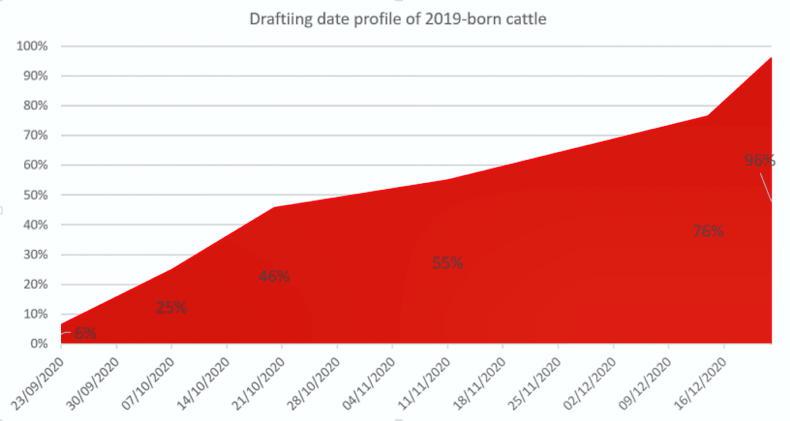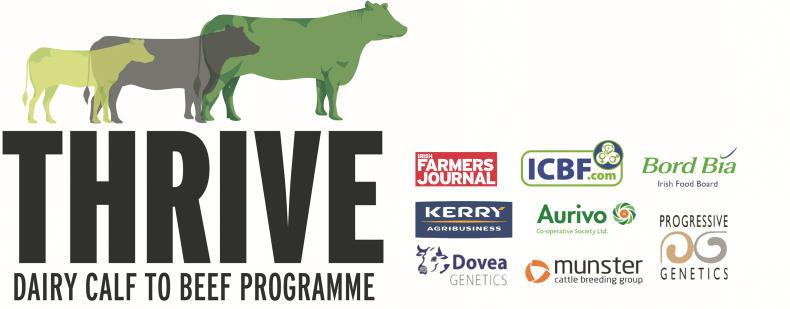Of the 140 calves bought in on the Thrive demo farm in Cashel, Co Tipperary, just five remain to be slaughtered.
A final draft of 25 cattle was made this week for slaughter just before Christmas.
The farm aims to kill as many cattle as possible off grass at the end of the second grazing season.
This year, 63% of the heifers and 32% of the bullocks managed to be slaughtered prior to housing.

Drafting profile of 2019-born Thrive demonstration farm cattle.
When we look at this on a breed basis for the heifers, 79% of Hereford and Angus, 60% of Limousin and 0% of Belgian Blue were slaughtered off grass.
For the bullocks, it was a similar story, with 64% of Hereford, 31% of Angus, 23% of Limousin and 0% of Belgian Blue slaughtered off grass.
Housing period
Housing was over a three-week period, starting in early October.
At the point of housing, the bullocks were on 4kg of meal, while the heifers were on 3kg of a 12.5% protein ration.
The bullocks moved up to 6kg initially post-housing and, in the last fortnight, that moved up to 8kg, as it was mainly Belgian Blue bullocks being fed.
The heifers moved up to 4kg post-housing and, again, this increased to 6kg for the last fortnight.
Post-housing, there was a three- to four-week lull where cattle needed time to adjust to the new diet and actually seemed to go backwards in terms of flesh cover for a period.
However, once they turned the corner again, performance for the remainder of the finishing phase was quite good.
Average slaughter age
The average slaughter age of all the cattle so far is just slightly over 20 months and with an average carcase weight of 285kg for heifers and 321kg for bullocks, it is a very respectable performance at a young slaughter age.
To achieve these results, there is no room for error - cattle must be performing every day of their lives.
These cattle are on a farm in south Tipperary where we can achieve an early turnout and graze well into the autumn.
More importantly, the attention to detail of farmer John Hally on all aspects of the production system is second to none.
These carcase weights would not be untypical for a 24-month dairy calf to beef system on some farms.

Of the 140 calves bought in on the Thrive demo farm in Cashel, Co Tipperary, just five remain to be slaughtered.
A final draft of 25 cattle was made this week for slaughter just before Christmas.
The farm aims to kill as many cattle as possible off grass at the end of the second grazing season.
This year, 63% of the heifers and 32% of the bullocks managed to be slaughtered prior to housing.

Drafting profile of 2019-born Thrive demonstration farm cattle.
When we look at this on a breed basis for the heifers, 79% of Hereford and Angus, 60% of Limousin and 0% of Belgian Blue were slaughtered off grass.
For the bullocks, it was a similar story, with 64% of Hereford, 31% of Angus, 23% of Limousin and 0% of Belgian Blue slaughtered off grass.
Housing period
Housing was over a three-week period, starting in early October.
At the point of housing, the bullocks were on 4kg of meal, while the heifers were on 3kg of a 12.5% protein ration.
The bullocks moved up to 6kg initially post-housing and, in the last fortnight, that moved up to 8kg, as it was mainly Belgian Blue bullocks being fed.
The heifers moved up to 4kg post-housing and, again, this increased to 6kg for the last fortnight.
Post-housing, there was a three- to four-week lull where cattle needed time to adjust to the new diet and actually seemed to go backwards in terms of flesh cover for a period.
However, once they turned the corner again, performance for the remainder of the finishing phase was quite good.
Average slaughter age
The average slaughter age of all the cattle so far is just slightly over 20 months and with an average carcase weight of 285kg for heifers and 321kg for bullocks, it is a very respectable performance at a young slaughter age.
To achieve these results, there is no room for error - cattle must be performing every day of their lives.
These cattle are on a farm in south Tipperary where we can achieve an early turnout and graze well into the autumn.
More importantly, the attention to detail of farmer John Hally on all aspects of the production system is second to none.
These carcase weights would not be untypical for a 24-month dairy calf to beef system on some farms.









 This is a subscriber-only article
This is a subscriber-only article












SHARING OPTIONS: